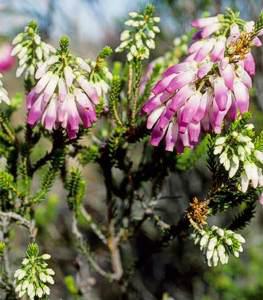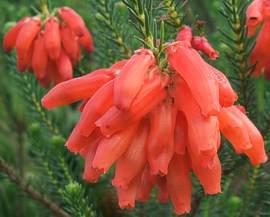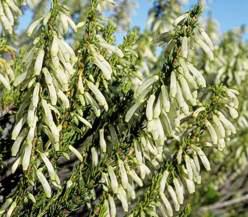Erica mammosa
Erica mammosa L.
Family: Ericaceae
Common names: nine-pin heath (Eng.); rooiklossieheide (Afr.)
Introduction
Erica mammosa is one of the few Erica species that has a spectacular range of flower colours, from white to pink, purple, orange and red.

Description
Description
Erica mammosa is a slow-growing and long-lived, robust, erect, well-branched shrub, 0.5-1.0 m tall, growing to a height of 1.8 m if left undisturbed. It has small, linear leaves, 6-10 mm long, arranged in whorls of 4 to 6. The flowers are inflated-tubular with a closed mouth and are 15-20 mm long. They form dense spike-like inflorescences, up to 200 mm long, towards the tips of the main branches. The flowers are borne singly or in pairs in the axil of a leaf. Flower colour varies from locality to locality and from bush to bush, ranging from orange-red, purple, dark red, greenish cream, and white, to various shades of pink.

These bright attractive flowers can be found throughout the year but mainly in summer and autumn (December to April).
After pollination the flowers dry, each holds a fruit with 4 locules/chambers containing numerous small seeds. The seeds are shed when ripe.
Conservation Status
Status
Erica mammosa is not threatened. Although it is not considered to be a threatened species at present, it could become so in the future if its natural habitat continues to be destroyed for agriculture and housing.
Distribution and habitat
Distribution description
Erica mammosa grows in sandy, well-drained soil which is nutrient-poor and acidic. It is commonly found on the sandy flats at sea level up to the higher mountain slopes but tends to favour sandy seepage areas. It is widespread from the Cold Bokkeveld to Hermanus and occurs in Clanwilliam, Pikketberg, Ceres, Worcester, Tulbagh, Paarl, Malmesbury, Stellenbosch, the Caledon District and on the Cape Peninsula.

Derivation of name and historical aspects
History
Erica is derived from the Greek ereiko meaning to break or rend, which may refer to the supposed abilities of some of the species to break up bladder stones, or could refer to the fact that stems are brittle and break easily. The name ereiko was used by Pliny and Theophrastus for a heath.
The species name mammosa comes from the Latin mamma meaning breast or udder and ose meaning full of or rich in, and refers to the shape of the flowers which resemble a cow's teats.
The Afrikaans common name rooiklossieheide means red-tufted heath and comes from the colour of the flowers and the way their arrangement resembles small tufts. Nine-pin heath comes from the way the shape of the flowers resembles a bowling pin.
This genus consists of ± 860 species across the world of which 760 species are found in South Africa and 104 are endemic to the Western Cape. The species that this one most often gets confused with is Erica sessiliflora, which has a similar flower shape and structure.
Ecology
Ecology
The tubular flowers of Erica mammosa are pollinated by sunbirds. After pollination, flowers dry and turn brown and the fruit develops inside. These fruits consist of 4 locules with numerous ovules producing many tiny seeds. E. mammosa survives fires and resprouts strongly from the rootstock.

Uses
Use
This perennial shrub is well suited to garden cultivation and has great horticultural potential due to the variety of colours within the species. Planting Erica mammosa in a garden amongst proteas, buchus, bulbs, daisies and ericas of different flowering times will provide colour all year. This species is very hardy and is able to grow in the Highveld areas. It will attract sunbirds to the garden.
Growing Erica mammosa
Grow
Erica mammosa should be planted in a sunny position with well-drained, sandy, acidic soil (pH 5 to 6.5). Avoid warm humid conditions and ensure that the area in which it has been planted has good air movement. Feed and mulch with well-rotted compost. Mulching the area around the shrub will keep the roots cool and suppress weeds. Do not disturb the roots as they are very sensitive. Protect the plant from extreme cold and frost. Pruning of the shrub should be done to remove diseased material and ensure healthy, multistemmed growth.

Erica mammosa can be propagated by cuttings or seed. A faster result is obtained from cuttings. Take semi-hardwood tip or heel cuttings, about 40-50 mm long, in late summer to autumn. Treat the cuttings with a rooting hormone and place in a well-drained, well-aerated rooting medium; preferably 50 % crushed pine bark and 50 % polystyrene. Place the cuttings in a mist unit with bottom heating of 22-24°C. Good air circulation will reduce fungal infection. Rooted cuttings should be handled with care as the roots are fine and are very sensitive to any disturbance.
Seeds can be harvested when they start to fall out of the flowers naturally. To harvest, cut off the older flowers before they shed their seeds, dry them, and extract the seeds by rubbing the dried flowers against a rough surface; clean them using graduated sieves. Sow seeds in autumn (April to May) into a tray not less than 100 mm deep. The sowing medium should be well drained and acidic, levelled and firmed down. Seeds should be sown evenly to prevent damping off and fungal diseases. This can be achieved by mixing the seeds with fine sand before sowing. Seeds can be smoke treated before or after sowing. To ensure maximum germination, night and day temperature fluctuation should be approx. 8-10°C (16 hours of night) and 15-25°C (8 hours of day), the same as those that occur in the Western Cape during autumn.
References
- Baker, H.A. & Oliver, E.G.H. 1967. Ericas in southern Africa. Purnell, Cape Town.
- Brown, N. & Duncan, G. 2006. Grow fynbos plants. South African National Biodiversity Institute, Cape Town.
- Jackson, W.P.U. 1990. Origins and meanings of names of South African plant genera. University of Cape Town Printing Dept, Cape Town.
- Oliver, I.& Oliver, T. 2000. Field guide to the ericas of the Cape Peninsula. Protea Atlas Project, National Botanical Institute, Cape Town.
- Schumann, D., Kirsten, G. & Oliver, E.G.H. 1992. Ericas of South Africa. Fernwood Press, Cape Town.
- Smith, C.A. 1966. Common names of South African plants. Memoirs of the Botanical Survey of South Africa No. 35.
- website: Plants of southern Africa : an online checklist. http://posa.sanbi.org.
Credits
Etienne Arendse and Alice Notten
Kirstenbosch National Botanical Garden
January 2009
Plant Attributes:
Plant Type: Shrub
SA Distribution: Western Cape
Soil type: Sandy
Flowering season: Sporadic/All year
PH: Acid
Flower colour: Purple, Red, White, Yellow
Aspect: Full Sun
Gardening skill:
Special Features:
Horticultural zones










Rate this article
Article well written and informative
Rate this plant
Is this an interesting plant?
Login to add your Comment
Back to topNot registered yet? Click here to register.